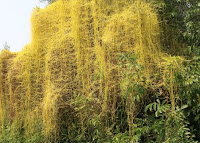The term "amazing plants in the world" refers to plants that possess unique and striking features, such as unusual shapes, vibrant colors, or exceptional survival abilities. Some examples of amazing plants include the Venus Flytrap, a carnivorous plant that captures insects for nutrients, and the Rafflesia, a rare and endangered plant with the largest single flower in the world. Other examples include the Corpse Flower, which has the largest unbranched inflorescence in the world, and the Slipper Orchid, with its distinctive slipper-shaped petals. These plants are found in various parts of the world and continue to fascinate botanists and plant enthusiasts.
Parasitic plants
Parasitic plants are a type of plant that derives nutrients and water from another plant, called the host plant, rather than from soil. These plants have specialized structures, such as haustoria, that allow them to tap into the host plant's vascular system and obtain the necessary resources. Example of parasitic plants-
 |
| Dodder plant |
1. Dodder plant (Common name),
Scientific name: Cuscuta reflexa Roxb.
Family: Convolvulaceae
Dodder
are a group of over 150 species in the genus Cuscuta. Dodder is a
leafless, parasitic weed that relies on its host for survival. These
species have a wide variety of host plants, including landscape and nursery grown
ornamentals.
 |
| Indian Pipe plant |
Scientific name: Monotrapa uniflora
Family: Ericaceae (Family)
Indian
pipe is a perennial wildflower with a wide geographic
distribution throughout the United States, from Maine to California and from
Florida to Alaska. It is absent from the southwest, intermountain west and the
central Rocky mountains.
3. Orobanche/broomrape (Common name)
 |
| Orobanche/broomrape |
Family: Orobanchaceae
Orobanche, commonly known as broomrape,
is a genus of almost 200 species of small parasitic herbaceous plants, mostly
native to the temperate Northern Hemisphere. It is the type genus of the
broomrape family Orobanchaceae.
Insectivours plants
Insectivorous plants, also known as carnivorous plants, are plants that obtain essential nutrients by capturing and digesting insects and other small animals. These plants typically thrive in nutrient-poor soil and have adapted to obtain necessary nutrients by producing modified leaves, stems, or roots that trap prey. Examples of insectivorous plants-
 |
| Venus flytraps |
1. Venus flytraps (Common name)
Scientific name: Dionaea muscipula J. Ellis
Family: Droseraceae
2. Pitcher plant (Common name)
 |
| Pitcher plant |
Scientific name: Nepenthes khasiana Hook. f.
Family: Nepenthaceae
3. Sundews (Common name)
 |
| Sundews |
Family: Droseraceae

No comments:
Post a Comment